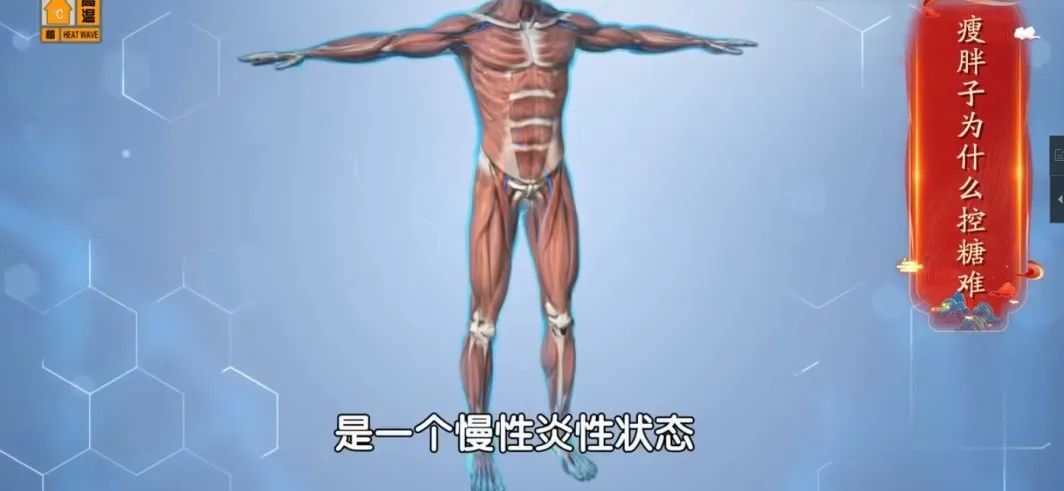Overall obese people have a 30% increased risk of type 2 diabetes compared to normal people, but people who are well-proportioned have a 38% increased risk of type 2 diabetes! Why is it that a person who looks normal is more likely to develop diabetes than obesity?

01What is “skinny and fat”?
“Skinny fat people” may look normal in appearance, neither obvious thinness nor obvious obesity, but this kind of “thin fat people” with too little muscle and too much fat can also be summarized as sarcopenia obesity .
This body type is the most prone to diabetes, which has a lot to do with muscle loss.

02Why is it difficult for “skinny fat people” to control sugar?
Why is less muscle, more prone to diabetes? In fact, in addition to maintaining the normal movement of the human body, muscle is also a large consumer of glucose. The energy during muscle exercise is provided by glucose.
If the muscle is reduced, the metabolism of the muscle itself will be reduced, and the amount of glucose consumed will also be reduced, resulting in a rise in blood sugar.

In addition, sarcopenia is a chronic inflammatory state that also exacerbates insulin resistance. Reduced glucose utilization and increased insulin resistance, coupled with a series of mechanisms, lead to high blood sugar levels, making it more difficult to control sugar.

Muscle is an important organ of life, but experts say that after the age of 40, muscle tissue decreases by 0.8% every year. Over the age of 70, muscle tissue decreases by 1.5% per year.
Subcutaneous fat continues to thicken and muscle gradually decreases, and it becomes “thin and fat”. At this time, it is also necessary to be alert to sarcopenia, or sarcopenia for short.
Muscle atrophy and decreased muscle strength are the root causes of many elderly people prone to falls. In addition, it also increases the risk of diabetes, cardiovascular and cerebrovascular events, and hyperuricemia.


There are 3 easy-to-follow self-testing little exercises to see if there is muscle loss.
1 go quickly
Walking a distance of 6 meters at a normal speed, if it takes more than 7.5 seconds, it means that the muscle function may have decreased.
2 Grip Dynamometer
Hold the grip dynamometer with your main hand, hold it to the end at one time, and check the value on the grip dynamometer.
Men’s grip strength is less than 28 kg, and women’s grip strength is less than 18 kg, which is considered to have weakened muscle strength. If you usually have to twist the towel and not clean your hands, you should be alert to sarcopenia.

3 measure the leg circumference
Use a soft ruler to measure the maximum circumference of both calves (average of both sides), the calf circumference is <34cm for males and <33cm for females, indicating that the muscle mass has decreased.
[Tips] The muscle mass test can also be done with the help of the hospital’s instruments. You may wish to add this item to the examination.


Recent studies have shown that when the body mass index (BMI) is relatively normal, “thin and fat people” may implement lifestyle interventions such as weight loss and muscle gain to achieve diabetes reversal.

1. Calorie restriction
If you want to gain muscle, strict calorie restriction is the key, but it is not a complete restriction. It is necessary to supplement high-quality protein to ensure a moderate supply of calories.
Low-fat meat (chicken breast, fish), eggs, milk, soybeans and their products are all sources of high-quality protein that can be easily obtained on a daily basis.

2. Reasonable exercise
To gain muscle, “thin and fat people” can do more resistance training, supplemented by aerobic exercise, and also need flexibility training and balance training.
3. Vitamin D supplementation
Vitamin D deficiency is prone to insulin resistance and metabolic disorders, which will promote the occurrence of sarcopenia and obesity.

And among people with type 2 diabetes, those with lower vitamin D levels had poorer glycemic control than those with normal levels. Studies have shown that the combination of vitamin D and hypoglycemic drugs can play a synergistic hypoglycemic effect and better control blood sugar.
Vitamin D is very low in natural foods, so it cannot be fully supplemented through food. The easiest and most practical way to supplement vitamin D is sun exposure.
The correct way to bask in the sun given by experts:
①Sunbathing time: The shadow is slightly longer than the body length. ②The location of sunbathing: sunbathe outdoors, do not bask in the sun through glass or apply sunscreen. ③The method of sun exposure: Expose your arms and palms every day for 15 minutes in the sun, 5 days a week.
Note: If sun exposure is insufficient, a vitamin D supplement may be required. We recommend BY-HEALTH’s calcium, vitamin D, and vitamin K soft capsules. Each capsule contains 180IU of vitamin D. When supplementing vitamin D, calcium is also supplemented. Click: “BY-HEALTH Calcium, Vitamin D, and Vitamin K Soft Capsules” for details.
Is there such a “skinny fat man” around you? Please forward this article to him/her!
Comprehensive health care in China